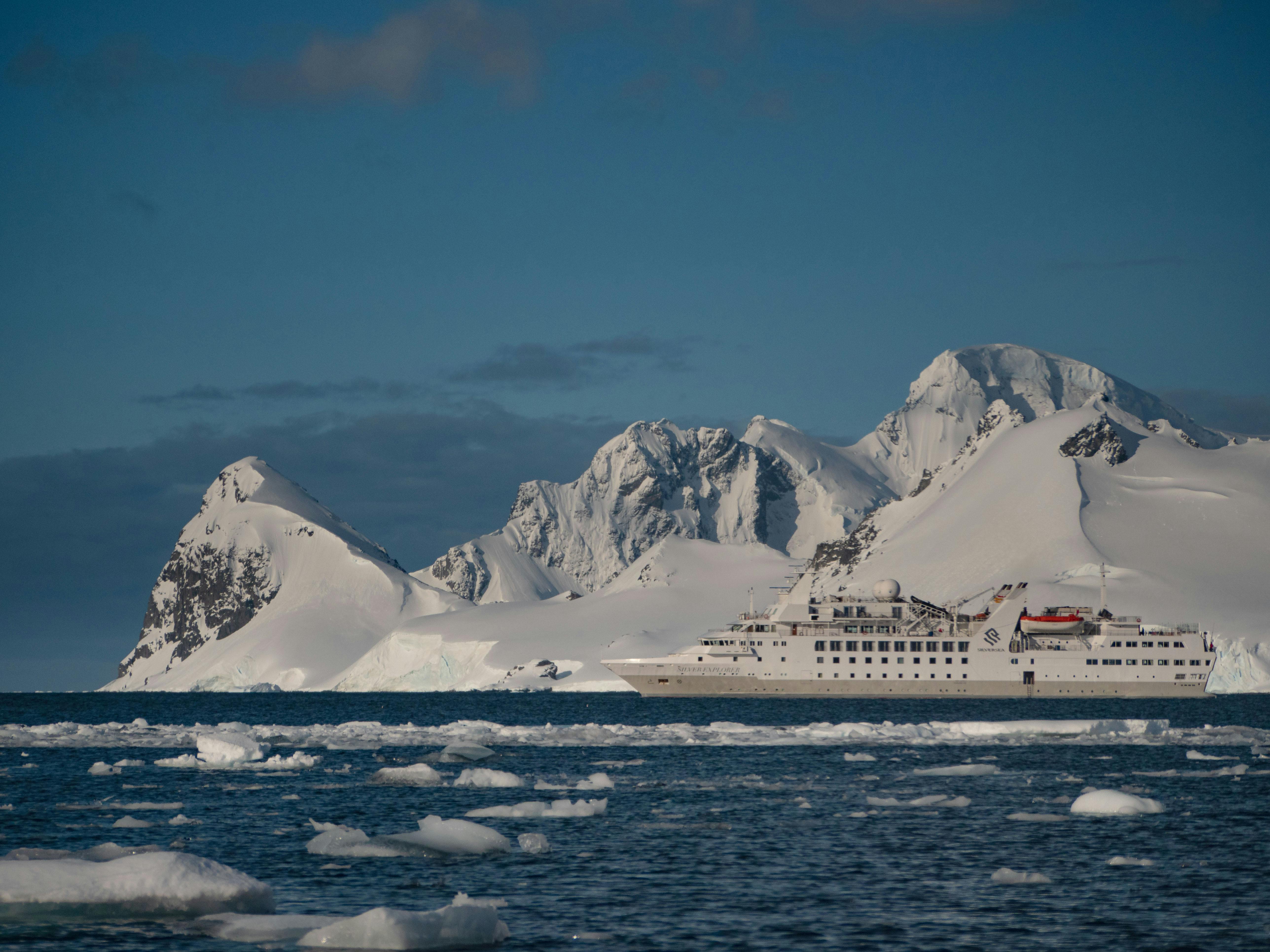A Flight to Remember: Silversea Celebrates Antarctica Return to Service in Groundbreaking Style
Instead of listing an occupation, Dave and Betty Frostad’s business card simply features the word “Travel” printed 12 times. The Sarasota, Florida couple have clocked in dozens of sail days with Silversea to far-flung destinations like the Russian Far East, Norway’s Svalbard Archipelago and India’s Andaman Islands, as well as a Silversea-organized overland excursion to landlocked Bhutan. So when Antarctica came calling, the Frostads seized the opportunity.
As first-time Silversea travelers to the Antarctica, they knew that their 18-day voyage from November 10-28 on board Silver Explorer – the inaugural voyage of the 2021-22 season – would yield countless personal milestones. What they hadn’t anticipated is that they would share one milestone with all of their fellow guests well before reaching the shores of the Antarctic Peninsula.
The Frostads were among the 38 guests on board the first-ever luxury flight from Santiago to Chile’s Patagonian port of Puerto Williams, the world’s southernmost town. Especially chartered for Silversea, the pioneering flight’s practical purpose was to conveniently connect travelers to a remote port on an island that has no roads to the outside world and just one regular air connection to the nearby city of Punta Arenas. And it just so happens that the nearly 1,500-mile route from Santiago hasn’t been operated in Chile for more than 30 years and never before as a luxury-style charter that aims to elevate the experience to the level of a domestic business-class flight.
“It was hard to imagine that the journey to the ship would be so significant,” said Dave Frostad upon completion of the maiden flight, set to be operated throughout the Antarctica season for Silversea’s roundtrip voyages out of Puerto Williams. “It just adds to the excitement of discovering Antarctica.”
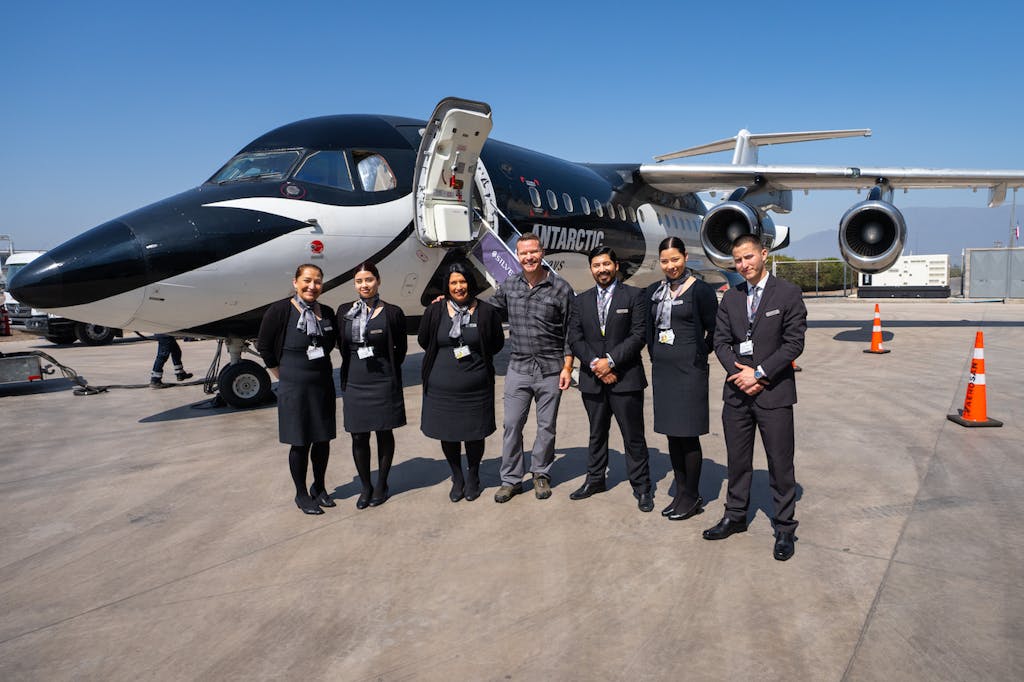
An Alliance Years in the Making
An exclusive collaboration between Silversea and Chile’s DAP Antarctic Airways, the November 10th flight brought half of Silver Explorer’s guests to the approximately 3,000-resident town that was chosen as one of the new Chilean gateways for Silversea’s Antarctic expeditions. A second flight departed less than an hour later with the remaining guests scheduled to board the expedition cruise ship. Also onboard the first flight were the masterminds behind this historic voyage: Conrad Combrink, Silversea Cruises’ Senior Vice President of Expeditions, Destination and Itinerary Management; and Nicolás Pivcevic, owner and CEO of DAP Antarctic Airways.
For Pivcevic, whose grandfather Daniel Andrés Pivcevic (after whose initials the airline is named) founded DAP in 1980, the occasion took on a special meaning. “Forty-one years ago, our very first flight landed in Puerto Williams from Punta Arenas on a 20-seat commuter aircraft, and my grandmother was the sole passenger,” the Chilean businessman announced over the airplane’s PA system, while en route to the tiny Patagonian town. “Today, I’m the first person in my family to fly this route and I couldn’t be more honored to share this milestone with the Silversea family.”
Combrink echoed the sentiment. “It’s a dream come true that’s been years in the making,” Combrink said.
The Silversea executive also highlighted the significance of launching the Antarctic season from Puerto Williams, which is the official capital of Antártica Chilena Province. The approximately 3,000-resident port sits on the southern shore of the Beagle Channel on scenic Navarino Island. Its extreme latitude makes it an obviously fitting launching site to explore the Last Continent, but Combrink also stressed that by being a small, easily accessible port, it enables guests a quick, seamless transition from flight to onboard suite. “Puerto Williams just ticks all the boxes,” added Combrink.
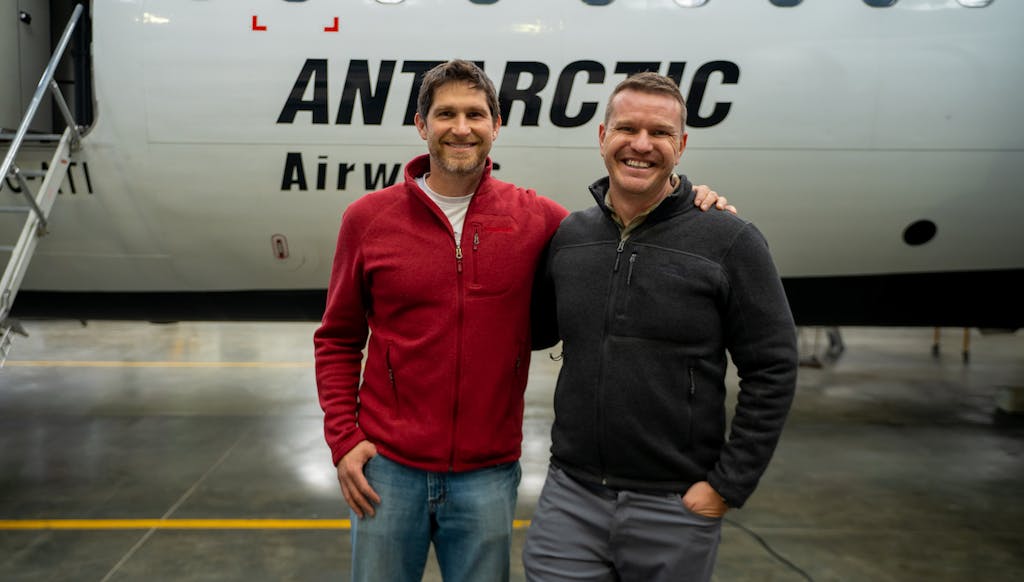
An Unforgettable Flight
For the Silversea guests on their way to their cruise, the journey began some 3,300 kilometers (2,062 miles) north of the Antarctic Peninsula, in Chile’s capital city of Santiago. After overnighting in the luxurious Mandarin Oriental hotel in the city’s posh Las Condes commune, the travelers were whisked to a private terminal in Santiago’s Arturo Merino Benítez International Airport.
In lieu of the traditional champagne flute, we were treated to a couple of local specialties in the private terminal’s lounge: Chilean Pisco Sour and Calafate Sour. The cocktails mirrored each terminus on either side of the flight, with the former representing the Chilean capital as the country’s national drink and the latter paying tribute to the Magellan barberry, a berry native to southern Chile and Argentina that’s considered a symbol of Patagonia.
Minutes later we came face-to-face with the airplane that in less than 4 hours would transport us to South America’s – indeed, the world’s – southernmost commercial airport. Aside from the Chinstrap penguin-inspired livery, what struck me the most about Antarctic Airways’ Avro RJ100 aircraft was the plane itself. A high-wing cantilever design with four turbofan engines cut a distinct sight from the typical low-wing look of most commercial narrowbody and widebody jets. Chatting with the airline’s CEO Pivcevic during the flight, I learned that this aircraft shines for its ability to land and take off in short runways, such as Puerto Williams’ 1,440 m (4,724 ft) airstrip. Moreover, the relatively high positioning of the engines comes in handy when landing in gravel runways such as the one in King George Island, Antarctica.
From inside the aircraft, the definition of “business-class-like luxury” became more clear. The entire cabin of the aircraft has been fitted to mirror the appearance of a domestic Business Class flight, reducing the number of seats to 80 from the standard 100 in order to achieve a comfortable, 36-inch pitch between each row. The 2 x 3 seat configuration, however, lacks the blocked middle seat arrangement commonly found in the business class cabin configuration on domestic flights.
But the experience really stood out with the onboard service. Shortly after departure, we were presented with the in-flight meal menu and drink service. The wide selection of alcoholic and non-alcoholic beverages was spearheaded by Chilean winery Concha y Toro’s Casillero del Diablo label – specifically the Devil’s Collection line – which proved a huge hit among the guests. Given the approximately three-hour-and-thirty-minutes flight duration, the menu was limited to a one-course meal. In keeping with the theme of locally-sourced ingredients and traditional dishes, the main course was a hearty, homey charquicán – an emblematic Chilean stew made with beef, potatoes, pumpkin, corn and peas, accompanied by a Chilean green salad of arugula, blue cheese, hydroponic lettuce and cherry tomatoes. For dessert, a tangy Calafate mousse brought a refreshing end to the culinary tour of Chile.

A little less than an hour into the flight, as Chile’s scenic and verdant Lakes Region started to come into view, I immediately understood another much more whimsical advantage of our aircraft’s high-wing design. By sitting above the windows, the wings didn’t obstruct the view as they normally do in low-wing aircraft. This allowed me and my fellow passengers to fully absorb the majestic display that unfolded 31,000 feet below.
Almost in perfect synchrony, we spent the better part of the second half of the flight gawking at every fjord, glacier, Andean peak and tucked-away hamlet. Standouts included a panoramic view of the massive Southern Patagonian Icefield – the world’s third-largest reserve of fresh water -, Argentina’s Perito Moreno Glacier, the soaring mountain peaks of Chile’s Torres del Paine National Park and the iconic Strait of Magellan.
As one last nod to the sightseeing bounty of the flight, our pilot Captain Arriadaga flew past Navarino Island, turning at the mouth of the Beagle Channel, in order to give us a scenic look at the iconic waterway before the final approach. The payoff was remarkable: Argentina on the right, Chile on the left; while the town of Puerto Williams, our ship and the island’s lush, Magellanic subpolar forests and jagged peaks came into closer view.
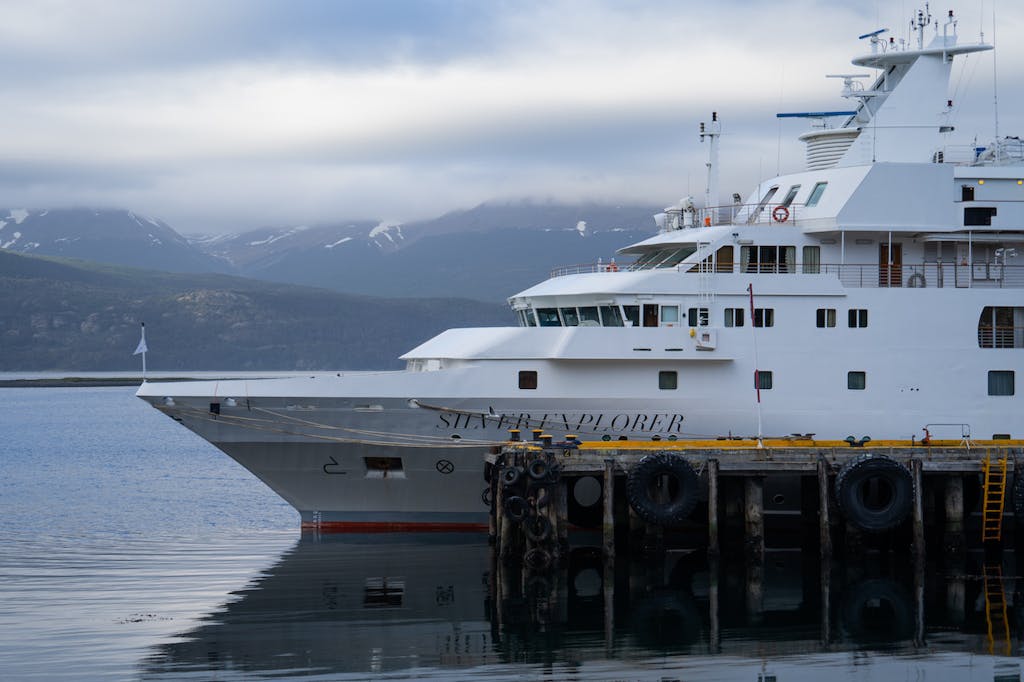
At the Ends of the Earth
Upon arrival at the airport at the ends of the Earth, we were greeted by the nippy embrace of November’s austral spring. Clouds hid the nearly 4,000-foot Dientes de Navarino (Teeth of Navarino) peaks, one of the island’s most iconic landmarks. In sharp contrast with Santiago’s sprawling aviation facility, Puerto Williams’ Guardiamarina Zañartu airport consist of a single, compact building that almost blends into the surrounding pastoral landscape. DAP is the only airline that services this airfield regularly, so it truly felt like we had the airport all to ourselves.
The transfers proceeded seamlessly, covering the distance of less than one mile from the airport to the Chilean Navy pier, where our ship awaited. It’s amazing how much information the local guide was able to squeeze during the brisk drive, going from basic facts about the area to history and even brief lesson on the local indigenous Yagan language.
At the pier, Patricio Fernández Alarcón, Mayor of Puerto Williams, was all smiles. Gleefully admitting that the Silversea ship had become a local celebrity, the mayor celebrated the significance of the alliance between cruise line and DAP Antarctic Airways.
“Today, we are reborn as a destination,” the mayor mused. “We are the ends of the Earth – or one might say we’re at the very beginning, depending on your perspective. Our island – our community – is special, just like Antarctica is special. We can’t be more proud to be the gateway for Silversea’s voyages of Antarctic exploration.”
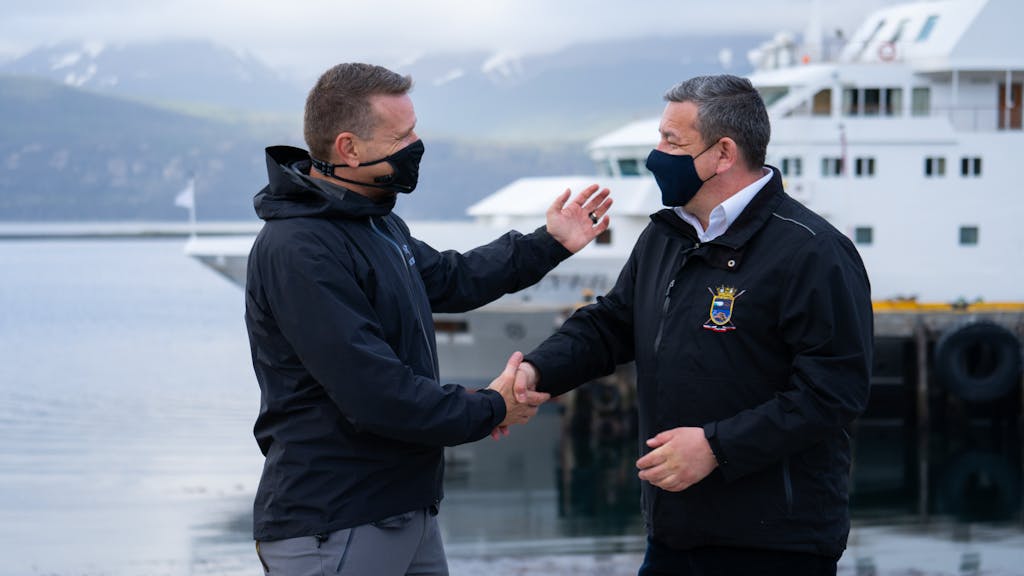
A few hours later, we sailed away down the Beagle Channel on her way to the South Shetland Islands.
“We turn dreams into memories, and I think that’s exactly what we accomplished here,” said Combrink. “People dream about Antarctica, and by facilitating access with logistical solutions like the flight down to Puerto Williams, we help make this dream a reality.”
